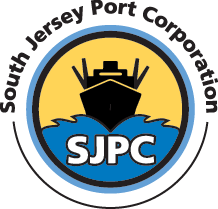FOR IMMEDIATE RELEASE
Camden, NJ — September 24, 2025 — South Jersey Ports (SJP) is proud to announce the appointment of Joseph A. Maressa Jr., Esq. as the new Chairman of the Board, and William R. Higgins as Vice-Chairman, marking a significant transition in leadership as Richard A. Alaimo, who has served as Chairman for an unprecedented 32 years, steps down from that role but will continue to contribute as a valued member of the Board of Directors. Brendan Dugan, Assistant Executive Director / Chief Commercial Officer, has agreed to serve as Interim Executive Director.
Joseph A. Maressa Jr., a seasoned attorney and entrepreneur, assumes the role of Chairman after serving as a board member for 20 years. Mr. Maressa has an extensive background in real estate and land use matters and is Co-Manager of Maressa-Patterson LLC. He also serves as President of Title America, an Acrisure Partner, and has earned the respect of his peers and the loyalty of many national, regional, and local residential and commercial builders for over 40 years. Maressa is a graduate of The Peddie School, Rowan University, and the Widener University School of Law. He serves on many boards, including The Jefferson Health System New Jersey, The Bank of Delmarva, Camden Diocese Real Estate Review Committee, and the Builders League of South Jersey Associates Committee. He is also a member of the Atco Lions Club.
Maressa has been actively involved with the SJP as a member of the Professional Appointments Committee and brings with him a strong commitment to regional economic growth, infrastructure investment, and community development.
“It is a tremendous honor to follow in the footsteps of Dick Alaimo, whose decades of leadership shaped the success of this organization,” said Maressa. “I am committed to continuing our mission of driving job growth, providing efficient port operations, and delivering long-term benefits to the communities we serve.”
William R. Higgins, newly sworn in as Vice Chairman, is a highly decorated retired New Jersey State Police captain and a former senior manager at the SJP. From 2007 to 2012, Higgins served as Director of Port Facilities Security, Human Resources, and Safety, becoming the first former SJP employee to be appointed to the board.
His law enforcement career included command roles in the Executive Protection Unit for Governor James Florio, as well as in Alcoholic Beverage Control Enforcement, Casino Gaming Enforcement, and as Chief of the Intelligence Bureau. After retiring from law enforcement, he led RSP Command Inc. as President & CEO. Higgins recently joined Xeed Acquisitions Group – a company committed to modernizing food infrastructure and eliminating systemic food insecurity – as its new Vice President of Government & Public Affairs.
“Bill brings a rare combination of operational experience, leadership, and institutional insight,” said Maressa. “His voice and vision will be instrumental as we navigate the evolving needs of the maritime shipping industry and regional economy.”
Alaimo, a founding Board member appointed in 1969 by Governor Richard J. Hughes, has now served under 17 different governors. Throughout his long tenure, he played a central role in the port’s evolution—from managing a single marine terminal in Camden to overseeing operations that now span four marine terminals across three cities. He has been instrumental in positioning SJP as a key economic engine for South Jersey, with a focus on job creation, industrial growth, and community revitalization.
“Dick Alaimo’s legacy as Chairman is truly extraordinary,” said Chairman Maressa. “While we will miss his leadership in the chairman’s role, we are deeply grateful that he will continue to lend his knowledge, experience, and institutional wisdom as a member of our board.”
Among his significant previous positions, Alaimo has served as the president of the Burlington County United Fund, the Mount Holly Rotary Club, and the Mount Holly State Bank. He was also the past president of the Rancocas Valley Regional High School Board of Education and remains a member of the board.
Brendan Dugan, who serves as Assistant Executive Director and Chief Commercial Officer, will also assume the position of Interim Executive Director. In his current role, Dugan has been responsible for leading efforts focused on cargo and revenue growth, implementing marketing and communication plans, overseeing the development of a Port Master Plan and Strategic Plan, and managing all SJP real estate transactions. He is a maritime professional with 40 years of experience in port terminal operations and logistics, sales and marketing, and negotiating complex lease and operating agreements.
Dugan holds an MBA from Northeastern University and a BA in Political Science from Boston College. His extensive career in the maritime industry and proven track record of building partnerships and driving growth will provide steady leadership during this transition.
This leadership transition represents both continuity and renewal for South Jersey Ports. With Maressa and Higgins at the helm, Dugan guiding executive operations, and Alaimo continuing to serve on the board, SJP remains rooted in experience while charting a course for the future.
The Board of Directors and executive team extend their deepest gratitude to Richard A. Alaimo for his decades of unmatched service and are proud that he will remain an active presence in shaping the port’s future.
Media Contact:
Jonathan Atwood
Chief of Staff and External Affairs
South Jersey Ports
856-757-4972
JAtwood@southjerseyport.com
www.southjerseyport.com



